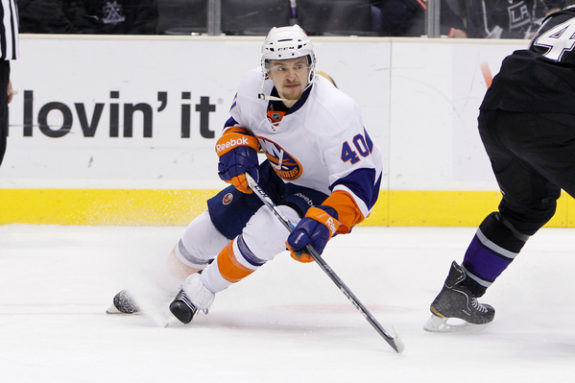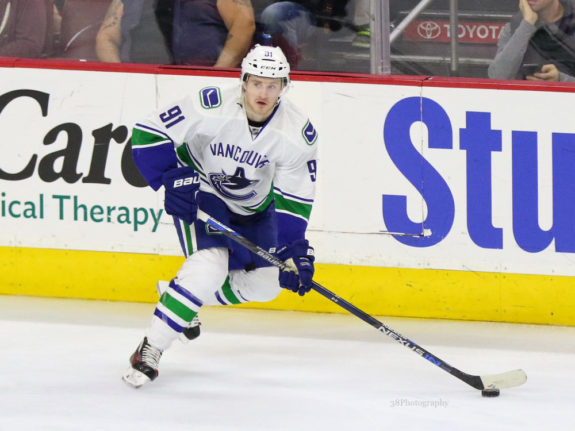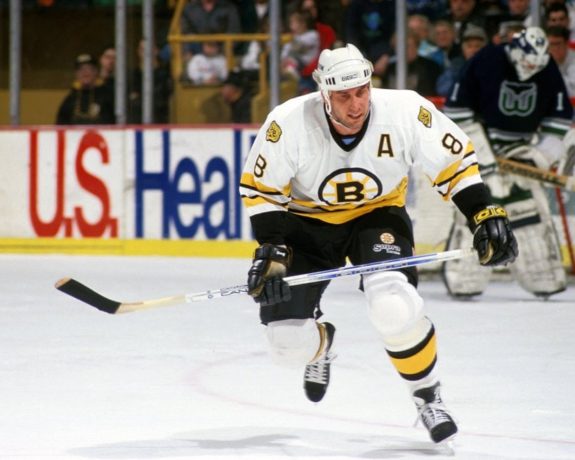*this archive was originally published in Aug. 2024
The Vancouver Canucks said goodbye (possibly too soon) to 23-year-old Vasily Podkolzin in Aug. 2024, sending him to their division rival Edmonton Oilers for only a 2025 fourth-round pick. He left Vancouver having played 137 games with only 18 goals and 35 points – 26 of which were scored in his rookie season back in 2021-22. Since he was drafted 10th overall in 2019, he has had a tumultuous career, first having success in the NHL with 14 goals in 79 games and then spending 72 games in the American Hockey League (AHL) over the 2022-23 and 2023-24 seasons.
Related: Hughes Brothers Named Cover Athletes for NHL 25
Podkolzin had a solid showing with the Abbotsford Canucks in 2023-24, scoring 15 goals and 28 points in 44 games. He also was developing a lethal one-timer and getting better defensively. When he was called up to Vancouver later in the season, he didn’t look out of place in the bottom-six showcasing increased physicality and two-way play. He finished with 70 hits in 19 games and parlayed that performance into a two-year contract extension, only to be traded a few months later.
I said in a recent article that Podkolzin was ready to take the next step and follow in Nils Hoglander’s footsteps in 2024-25. But now that will likely happen in Edmonton, which would make him yet another young player the Canucks have given up on too soon. Let’s take a look at four others in their history.
Michael Grabner
Drafted 14th overall by the Canucks in 2006, Michael Grabner was lauded for his lightning speed and pure offensive game. He was a natural goal scorer who used his skating and shot to ignite the offence and put himself on highlight reels. He came over to North America at a very young age, joining the Spokane Chiefs in the Western Hockey League in 2004-05 and quickly established himself as a threat in the league. He had an okay rookie season with 13 goals and 24 points, but broke out in his draft year with 36 goals and 50 points. He played one more season with the Chiefs in 2006-07, scoring a career-high 39 goals and 55 points and made his debut with the Manitoba Moose once the Chiefs were eliminated from the WHL Playoffs.
You may also like:
- Canucks News & Rumours: Boeser, Lankinen & Road Woes Continue
- NHL Rumors: Andersson Trade Near, Hronek Buzz, Oilers Goalie Update
- Insider Reports Rangers Made Solid Offer for Canucks’ Kiefer Sherwood
- NHL Morning Recap – January 16, 2026
- NHL Rumors: Stolarz Trade, Pettersson Calls, Bruins in on Andersson
The Canucks kept Grabner in the AHL for two seasons before calling him up to the NHL for the first time. During that time, he had two 20-goal seasons, including a career-high 30 goals in 2008-09, and became one of the AHL’s top scoring threats. He made his NHL debut on Oct. 16, 2009, against the Calgary Flames and recorded an assist in 12:06 of ice time. He was sent down after nine games but returned to the lineup in March and finished the season in the NHL. His first goal came against the Chicago Blackhawks on Oct. 21, 2009, but the biggest highlight was a hat trick on April 2, 2010 against the Anaheim Ducks.
Grabner’s stint in the NHL got fans excited about what he could bring to the lineup in 2010-11, as he was projected to start on a line with fellow speedsters Ryan Kesler and Mason Raymond. Unfortunately, then-general manager Mike Gillis thought they needed an upgrade on defence and dealt him in a package with Steve Bernier to the Florida Panthers for Keith Ballard and Viktor Oreskovich. He didn’t suit up for the Panthers, though, as he was claimed off waivers by the New York Islanders after he didn’t make the roster in training camp.

The rest, as they say, is history. Grabner went on to score 34 goals in his rookie season, finishing third in Calder Trophy voting and even got votes for the Lady Byng and Selke. He became a threat on the penalty kill too, scoring six shorthanded goals using his speed and acceleration to blow past unsuspecting defenders at the point. And to think, he was criticized for being all-offence and no defence. He never got to 34 goals again in his career but finished with 175 goals and 276 points in 640 games, which included three more 20-goal seasons and 22 shorthanded goals split between the Canucks, Islanders, New York Rangers, Arizona Coyotes, Toronto Maple Leafs and New Jersey Devils.
Regrettably, Grabner only played 20 games in Vancouver because management didn’t give him a chance to play a full season in the NHL. I still remember the disappointment I felt in 2010 when they traded him to the Panthers, knowing that we would never get to experience the excitement that likely would have been a potent second line of Raymond, Kesler and Grabner. The Canucks had a dominant season in 2010-11 and made it to the Stanley Cup Final, but still, that trio would have been fun to watch and probably would have contributed to that success too.
Jared McCann
When Jim Benning took over as the Canucks GM in 2014, he was put into a pickle right off the bat. He had to deal with Kesler’s trade request and try and get the best return when every GM knew Kesler wanted out of Vancouver. While there are mixed reviews on whether he did that, he got a first-round pick, Luca Sbisa, and Nick Bonino from the Anaheim Ducks for the former 40-goal scorer. As a result, Benning had two first-round picks going into the 2014 NHL Draft and decided to use them on Jake Virtanen (sixth overall) and Jared McCann (24th overall). Now 10 years later, that first round is viewed as one of the worst in franchise history, as Virtanen was only ever a borderline top-nine forward and is now in Europe and McCann was traded for a bruising defenceman they never really needed.

If the Canucks had kept McCann, the 2014 Draft would be looked back on a lot more fondly right now. While it took a bit for him to find his footing in the NHL as a top-six forward, he is now a three-time 20-goal scorer and recently had a career-high 40 goals in 2022-23. He is also one of the Seattle Kraken’s core players and is in the middle of his prime years. Hindsight is of course 20/20, but would he of matured quicker if he had been with the Canucks longer than 69 games in 2015-16? He did admit he was rushed into the NHL as a 19-year-old, and that might be further inditement on the Benning regime which probably shouldn’t have allowed both Virtanen and McCann to play full seasons in the NHL at such a young age.
“I personally think that I could have used a year in the AHL. I really do. Mentally, I think it would have helped me. Physically, it would have helped me. I was 172 pounds playing in the NHL as a 19-year-old. You get tossed around.”
– Jared McCann on his time with the Canucks
Regardless, the Canucks traded McCann far too soon and rumours of his “bad attitude” at the time notwithstanding, he showed promise in his rookie season. His biggest asset was clearly his shot as he showcased it multiple times, scoring nine goals and 18 points. He could have been sent down to the AHL in 2016-17 for further development and likely would have turned into a tremendous player for the Canucks. Instead, he was dealt to the Panthers for 6-foot-5 Erik Gudbranson because Benning felt his blue line lacked size and toughness. In the end, he was wrong as Gudbranson struggled and was eventually traded to the Penguins in 2019 for Tanner Pearson after an underwhelming 139 games in Vancouver. McCann, meanwhile, might have turned into one of the core pieces of the team alongside Bo Horvat and Brock Boeser if the initial trade wasn’t made.
Rick Vaive
What would Canucks history look like if both Rick Vaive and Cam Neely played more than 248 games in Vancouver? It’s difficult to say for sure, but the chances of a Stanley Cup would have been much higher as they could have been teammates if they didn’t trade them away so soon.
Related: Canucks Forgotten Ones: Rick Vaive
Starting with Vaive, he was drafted fifth overall by the Canucks in 1979 and only suited up for 47 games before getting traded in a package with Bill Derlago to the Toronto Maple Leafs for Jerry Butler and Tiger Williams. While Williams became a fan favourite and had one memorable 35-goal season in 1980-81, Vaive turned into a prolific goalscorer with the Maple Leafs. In fact, he is one of the franchise’s leaders in goals and points sitting sixth and 12th respectively. It didn’t take long for him to hit his peak either, scoring 50 or more goals three seasons in a row from 1981 to 1984 and 30 or more in every season after he arrived in Toronto. Before he was dealt in 1987 to the Chicago Blackhawks for Eddie Olczyk and Al Secord, he had 299 goals and 537 points in 534 games.
Vaive never hit 50 goals again in his career, but he still finished with 441 goals and 788 points in 876 games and held the Maple Leafs single-season record for goals with 54 until Auston Matthews broke it in 2021-22 when he hit 60. Suffice it to say, the Canucks missed out on a very special player that likely would have reached similar summits had he not been traded at only 20 years old.
Cam Neely
If you have been a Canucks fan for any length of time, you know about Cam Neely. He was a Canuck for 201 games, but the future Hall of Famer didn’t have any of his special moments in Vancouver. He broke into the league right away after being drafted ninth overall in 1983, scoring 16 goals and 31 points in 56 games and had his first 20-goal season in 1984-85. But the Canucks decided that he was progressing too slowly and traded him in 1986 to the Boston Bruins for 24-year-old Barry Pederson who had two 40-goal seasons under his belt and had cracked the century mark twice (107 points in 1982-83; 116 points in 1983-84).
At the time, the trade looked like it was going to be a win for the Canucks, or at least an even swap. Unfortunately, as history tells us, it was anything but. While Pederson had a decent 60 goals and 197 points in 233 games in Vancouver, he never touched the heights that Neely did with the Bruins. Not only did Neely become an elite player, but a superstar and icon in Boston sports. He finished with 344 goals and 590 points in 525 games, eclipsed the 50-goal mark three times, and never ended a full season with less than 25 goals. The only times he finished with less than that was during his injury-riddled seasons in 1991-92 and 1992-93.

Neely was also a beast in the playoffs. In 86 games, he scored a whopping 55 goals and 87 points, leading the Bruins to the Stanley Cup Final in 1988 and 1990. He never got to hoist the trophy though as they went up against the dynastic Edmonton Oilers both times. Regardless, he ended his career as one of the top power forwards in NHL history, but far too soon at the age of 31. If his body would have held up, he likely would have won the Cup at least once. Still, what he accomplished was worthy of the Hall of Fame as he was inducted in 2005 after getting his No. 8 retired by the Bruins in 2004.
What could the Canucks have looked like with him leading the charge in the 90s with (potentially) Pavel Bure and Trevor Linden? In an alternate universe, they might have won the Stanley Cup. We will never know, because they gave up on him way too soon for a supposed proven commodity in Pederson.
Will Podkolzin Join This List in the Future?
Hopefully, I won’t be adding Podkolzin to this list in a few years. He is still only 24 years old and has not hit his prime yet. With the opportunity to play alongside Connor McDavid or Leon Draisaitl, he might break out and make the Canucks regret trading him. He showed strides in his game in 2023-24 in the AHL, and while many people think it was taking too long for him to establish himself as a top-six talent, I argue they didn’t give him enough of a chance to do so. He will probably get that chance in Edmonton, and it’s up to him to snag it. If he does, we could see him become one of the biggest “what ifs” in franchise history.
